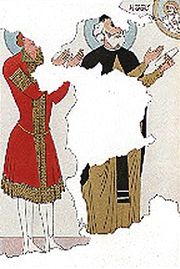George II of Georgia
| George II გიორგი II |
|
|---|---|
| King of Kings of Georgia | |

A fragment of the fresco from the Ateni Sioni Church, purportedly depicting George II as a monk after his abdication in 1089. Reproduction by Grigory Gagarin, 1847
|
|
| King of Georgia | |
| Reign | 1072–1089 |
| Coronation | 1050–1053 in opposition to father |
| Predecessor | Bagrat IV |
| Successor | David IV |
| Born | c. 1054 |
| Died | 1112 |
| Spouse | Elene |
| Issue | David IV |
| Dynasty | Bagrationi |
| Father | Bagrat IV of Georgia |
| Mother | Borena of Alania |
| Religion | Georgian Orthodox Church |
George II (Georgian: გიორგი II, Giorgi II) (c. 1054 – 1112), of the Bagrationi Dynasty, was a king of Georgia from 1072 to 1089. He was a son and successor of Bagrat IV and his wife Borena of Alania. Unable to deal effectively with the constant Seljuk Turkish attacks and overwhelmed by internal problems in his kingdom, George was forced to abdicate in favor of his energetic son, David IV, to whom he remained a nominal co-ruler until his death in 1112. He also held the high Byzantine titles of curopalates (c. 1060) and caesar (c. 1081).
George’s childhood coincided with the civil war between his father, Bagrat IV (r. 1027–1072), and the rebellious Georgian feudal lord Liparit, who succeeded in temporarily driving Bagrat into the Byzantine Empire, and crowned George as king at the Ruisi Cathedral between 1050 and 1053, under the regency of Bagrat's sister Gurandukht. In fact, Liparit became the master of nearly half of the Georgian kingdom and the most powerful dynast in the country. By 1060, Bagrat IV had been able to secure the throne and made George his heir apparent to whom the Byzantine emperor attached the title of curopalates. In 1070, Prince George, at the head of a combined Georgian-Alan army, inflicted a decisive defeat on the Shaddadid emir of Arran, Fadl II, and ravaged his possessions at Ganja.
...
Wikipedia
